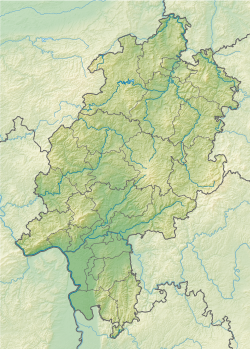Menhir of Istha
| Menhir of Istha | ||
|---|---|---|
|
|
||
| Coordinates | 51 ° 17 '22.5 " N , 9 ° 14' 31.5" E | |
| place | Wolfhagen , OT Istha , Hesse , Germany | |
| Emergence | early bronze age ? | |
The menhir of Istha is an ornate prehistoric menhir from Istha , a district of Wolfhagen in the Kassel district in Hesse . It was discovered in 1969 and is now in the Wolfhager Land Regional Museum .
location
The stone was discovered in 1969 while plowing. It was located on a hillside southeast of Istha, north of the former country road to Martinhagen near the Herbshausen desert . In the vicinity of the site there are said to be further large, non-local sandstone blocks .
description
The menhir was found face down. It consists of quartz sandstone and is only partially preserved. It is pyramidal and has breaklines at the top and bottom. The fragment obtained has a height of 94 cm, a width of 71 cm and a thickness of 32 cm. On one broad side the stone has an engraved illustration: At the lower edge there is a large circle overlaid in the middle by a narrow rectangle running obliquely from top left to bottom right. In the upper half of the circle there are two smaller circles with small holes in their center (the holes could also have been created naturally). Above the large circle, in the middle of the stone, there is a horseshoe-shaped structure. From this a short line goes off on the left, which has two clearly thinner conductor strips at its end.
The depiction is similar to that on a number of other decorated stones, such as a plate from the nearby gallery grave of Züschen or several menhirs from Saxony-Anhalt (e.g. Schafstädt and Pfützthal ) and should therefore be classified as belonging to the late Neolithic or the early Bronze Age . It could be a highly stylized representation of a person wearing a shoulder strap that leads over a shield or a piece of jewelry. According to Fritz-Rudolf Herrmann and Albrecht Jockenhövel , the depiction most closely fits into the early Bronze Age, but a dating to the La Tène Age cannot be ruled out.
literature
- Johannes Groht : Menhirs in Germany. State Office for Monument Preservation and Archeology Saxony-Anhalt, Halle (Saale) 2013, ISBN 978-3-943904-18-5 , pp. 137, 155.
- Fritz-Rudolf Herrmann , Albrecht Jockenhövel : The prehistory of Hesse . Theiss, Stuttgart 1990, ISBN 3-8062-0458-6 , pp. 172-173, 502.
